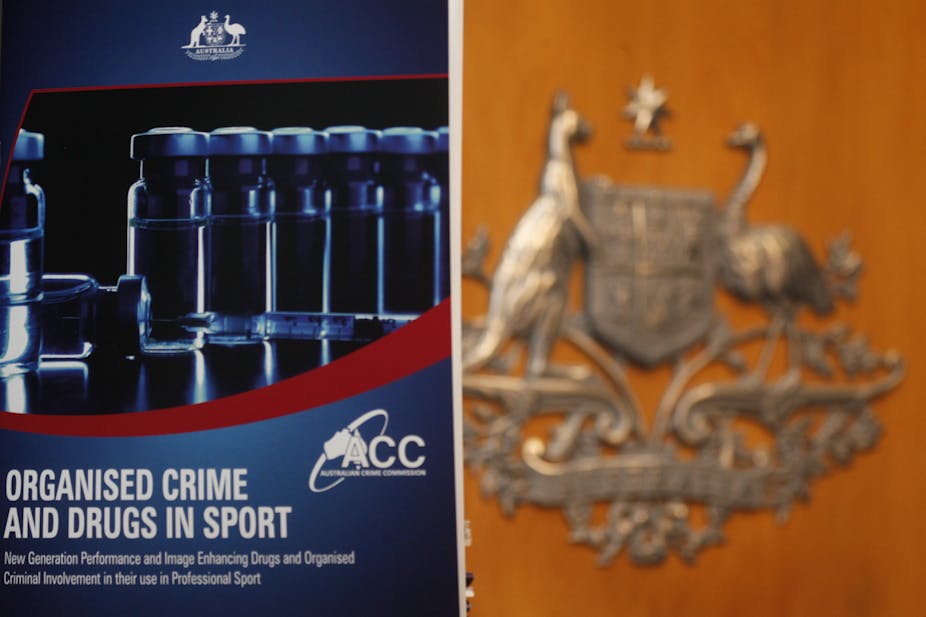The Australian Crime Commission report, Organised Crime and Drugs in Sport, has come as a hammer blow to Australian sport. According to a review of cycling released only last month, Australia is supposed to have a reputation of being “clean” on these matters. Just weeks later, that has all been swept away.
So, how did it come to this? Like any social problem, it is the result of a whole host of things. Untangling them is to approach a Gordian Knot without even a blunt pen knife.
The management of drugs in sport in Australia and around the world is led by the anti-doping policy. Anti-doping is in essence a “legalistic prohibitionist” policy. It seeks to detect and punish to deter drug use. Attempts at alcohol prohibition throughout history have emphatically demonstrated what this kind of policy does. Underlying demand is unaffected, while legal supply disappears. This creates the opportunity for organised crime to become the supplier, with inflated prices for overcoming legalistic interdiction (policing).
Sport is big business, worth nearly $9 billion in Australia. Game day is the outcome of a lengthy and convoluted production process. What matters is the objective outcome when that day ends. If the sponsors, broadcasters and punters are happy - the managers are happy. Few resources are directed anywhere else. The Cycling Australia Review, for example, reported anti-doping was the responsibility of a part-time employee handling 40,000 competitive riders and their events. Cycling Australia saw investment in events as far more important than “the fight against doping”.
The competition between sports, such as Australian Rules and Rugby League, leads to the constant pressure to develop a competitive advantage. This is the constant nightmare of big business, preserving market share while expanding into new areas. Part of this mix is making the sport provide “more” - more excitement, more thrills, more nerve shattering moments. This is what sports consumers want; it’s what they demand. Failure to meet this demand means less money at the gates.
The production process to meet this demand rests on the athlete. In pursuit of “more”, athletes have to find ways to be higher, faster, stronger. This is compounded by pressure to return from injury as soon as possible. Athletes might just need to hang in for another season before looking for an alternative career.
Australian athletes can and do use performance enhancing substances because they have to. It is impossible to be competitive at the elite level without using some kind of substance. Athletes can lose their job if they heal too slowly. This creates a demand for performance enhancing substances that organised crime is only too happy to meet, with multi-billion dollar reward.
The government would have us believe the answer rests in ramping up anti-doping exercises to “catch” baddies - investing more in detection and making punishment more severe. Let’s be clear: making anti-doping work is going to cost a lot of money. In the current fiscal climate, that money is going to have to come from health, education, defence or welfare. This raises the question of whether “clean sport” is more important than, say, the National Disability Insurance Scheme.
Unfortunately, putting anti-doping on steroids is unlikely to do much. This approach has failed to prevent the rising market of illicit drugs in Australia - at least if Australia 21 is to be believed. The war on drugs has failed, and it seems reasonable to assume the “war on drugs in sport” is going to end the same way.
One way of resolving the problem is to move from anti-doping to drug control. Let’s look at developing ways to better understand the role of drugs in sport. A host of substances are already permitted. There are clearly some drugs that should be banned - a hockey player smacked out on ice is a danger to themselves and everyone else. But that does not apply to all substances. Unfortunately, this idea is unlikely to be palatable to those who have invested heavily in “zero tolerance” - which John Fahey, President of WADA, has repeatedly declared an unrealistic goal anyway.
Another solution is to change the nature of sport. What might professional sport look like if it emphasised the joy of the game? One reason athletes demand performance enhancing drugs is because of the inhuman expectations placed on them. Let’s change our expectations. Making seasons shorter is a simple way of giving athletes more time to recover from injuries. Looking at rotation policies might be a good way forward too. Putting athlete health and welfare on some kind of level footing with other costs of doing business might be a useful start, (though this is unlikely to be palatable to business interests).
Of course, like any social policy, the answer is to implement all these solutions at once. Australia needs to accept the reality that drugs are an inimical, yet intrinsic part of sport. We must find a better way of policing drugs in sport, and shift the focus away from business and towards human interests.
Perhaps then we can get back to sport being about the talent, grace, skill and strength of some extraordinary people.

